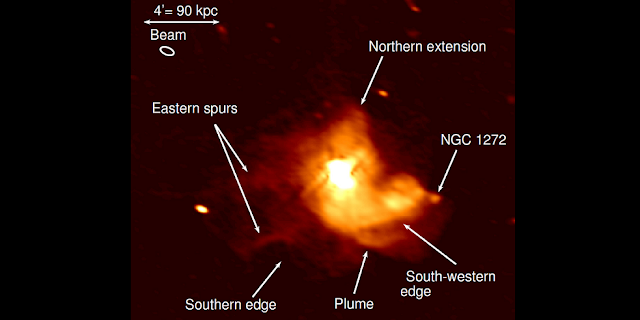The largest gravitationally bound objects in the universe are galaxy clusters that form at the intersection of cosmic web filaments. These entities are shaped and grow through massive collisions as material streams into their gravitational pull. Within the heart of some galaxy clusters are mysterious and little known radio mini-halos. These rare, dispersed, and steep-spectrum (brighter at low frequencies) radio sources surround a bright central radio galaxy and are highly luminous at radio wavelengths.
Studying this phenomenon is Dr. Tracy Clarke, a radio astronomer at the U.S. Naval Research Laboratory (NRL) Radio Astrophysics and Sensing Section and co-author of research on the topic titled, "Deep 230-470 [megahertz] VLA Observations of the mini-halo in the Perseus Cluster." She works in conjunction with the National Radio Astronomy Observatory (NRAO), the research team uses the upgraded Karl G. Jansky Very Large Array (JVLA) to peer into the cluster of galaxies in the constellation Perseus, 250 million light-years from Earth.
"In 2011, an upgrade to the receivers on the JVLA sacrificed the observatory's capability for operation at frequencies between 30 MHz and 300 MHz," said Clarke. "However, in 2013 all 27 of the 25-meter antennas of the JVLA were outfitted with new receivers, providing the bandwidth necessary for these observations."
According to Clarke the Perseus cluster is one of the most massive objects in the known universe, containing thousands of galaxies immersed in a vast cloud of multimillion-degree gas and harbors a minihalo. Mini-halo systems are thought to provide a window on the otherwise elusive turbulence driven by minor mergers between galaxy clusters and less massive systems.
Funded by NRL, the new broadband low frequency receivers have widened the VHF/UHF receiver bandwidth from 300-340 MHz to 230-470 MHz, significantly increasing the sensitivity of the telescope. The new JVLA facilities have also produced an order of magnitude of deeper image quality than previous high fidelity data, which lets the mini-halo emissions be seen clearly at the 270-430 MHz range.
“Overall, the recently upgraded JVLA has enabled a breakthrough in radio astronomy by providing a radio telescope with unprecedented sensitivity, resolution, and imaging capabilities," said Julie Hlavacek Larrondo, Universite de Montreal astrophysicist and a lead author of the paper. "The new JVLA images of the Perseus cluster demonstrate the unique and state-of-the-art capabilities that this telescope offers to the community."
The deep JVLA observations of the Perseus cluster, combined with the cluster's properties, offer researchers a unique opportunity to study mini-halo structures. Lead author Marie-Lou Gendron-Marsolais, Ph.D. student at Universite de Montreal notes, "The results demonstrate the sensitivity of the new low frequency JVLA receivers, as well as the necessity to obtain deeper, higher-fidelity radio images of minihalos in clusters to trace complex structures and further understand their origin."
Recognizing the power of the new VHF/UHF receiver, NRL wanted to enhance the availability of this new resource. In 2014, NRL and NRAO researchers worked to develop the VLA Low Band Ionospheric and Transient Experiment (VLITE) to tap into the new broadband low frequency receivers and piggyback on the $300 million dollar infrastructure of the JVLA.
"The data stream from this new system can be tapped to expand our understanding of objects such as these mini-halos while at the same time providing real-time monitoring of ionospheric weather conditions over the U.S. southwest," Clarke said.
At present, VLITE is being further expanded (eVLITE) to more than double the number of baselines from the original 45 baselines to 104 and should be fully operational by the end of August 2017. The expansion, to date, has brought a total of 66 baselines to VLITE.
Astronomers use VLITE for a wide range of astrophysics, which includes exploring the sky for shortlived bursts of radio waves. This type of research continues to grow in importance, since a small number of such events have led astronomers to suspect still-undiscovered phenomena in the universe may be producing many such powerful bursts.
Credit: nrl.navy.mil

No comments:
Post a Comment